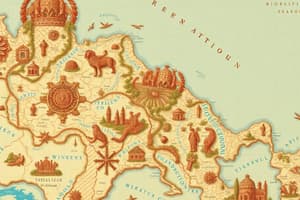Podcast
Questions and Answers
What does the Natural Increase Rate (NIR) measure?
What does the Natural Increase Rate (NIR) measure?
- The percentage of people emigrating from a country
- The difference between crude birth rate and crude death rate (correct)
- The total population including migration
- The total number of immigrants in a country
The Population Growth Rate does not consider migration.
The Population Growth Rate does not consider migration.
False (B)
What is the primary function of the Demographic Transition Model (DTM)?
What is the primary function of the Demographic Transition Model (DTM)?
To analyze and predict trends in population growth and decline.
The doubling time is the number of years in which a population will ______, assuming the growth rate stays the same.
The doubling time is the number of years in which a population will ______, assuming the growth rate stays the same.
Match the following demographic terms with their definitions:
Match the following demographic terms with their definitions:
Which stage of demographic transition is characterized by a rapid natural increase rate due to improved nutrition and sanitation?
Which stage of demographic transition is characterized by a rapid natural increase rate due to improved nutrition and sanitation?
Stage Five of demographic transition is characterized by population growth due to high total fertility rates.
Stage Five of demographic transition is characterized by population growth due to high total fertility rates.
What are the primary reasons for high crude birth rates (CBR) in Stage One of demographic transition?
What are the primary reasons for high crude birth rates (CBR) in Stage One of demographic transition?
In Stage Four of demographic transition, life expectancy continues to increase, and the natural increase rate __________.
In Stage Four of demographic transition, life expectancy continues to increase, and the natural increase rate __________.
Match the countries with their respective demographic transition stage:
Match the countries with their respective demographic transition stage:
What is the Total Fertility Rate (TFR) associated with replacement level in Stage Five?
What is the Total Fertility Rate (TFR) associated with replacement level in Stage Five?
Thomas Malthus believed that food production would increase exponentially.
Thomas Malthus believed that food production would increase exponentially.
Name one outcome of Malthus' thesis regarding population growth.
Name one outcome of Malthus' thesis regarding population growth.
Which factor is most commonly associated with migration?
Which factor is most commonly associated with migration?
Women are more likely to migrate longer distances compared to men.
Women are more likely to migrate longer distances compared to men.
What is the term for those who have fled their country due to violence or persecution?
What is the term for those who have fled their country due to violence or persecution?
The practice of moving livestock seasonally is known as _____ .
The practice of moving livestock seasonally is known as _____ .
Match the type of migration with its description:
Match the type of migration with its description:
Which language family has the largest number of speakers worldwide?
Which language family has the largest number of speakers worldwide?
Which of the following best describes internally displaced persons?
Which of the following best describes internally displaced persons?
Economic effects of migration on receiving countries primarily involve an increase in unemployment.
Economic effects of migration on receiving countries primarily involve an increase in unemployment.
Pidgin refers to a standard language that is commonly spoken worldwide.
Pidgin refers to a standard language that is commonly spoken worldwide.
What is the term for a geographic boundary within which a particular linguistic feature occurs?
What is the term for a geographic boundary within which a particular linguistic feature occurs?
What visa is commonly associated with temporary, seasonal agricultural workers in the US?
What visa is commonly associated with temporary, seasonal agricultural workers in the US?
People who adopt elements of a dominant culture while still retaining aspects of their original culture are experiencing __________.
People who adopt elements of a dominant culture while still retaining aspects of their original culture are experiencing __________.
Match the following terms with their correct definitions:
Match the following terms with their correct definitions:
Which of the following is an example of a branch within the Indo-European language family?
Which of the following is an example of a branch within the Indo-European language family?
Universalizing religions tend to have a smaller geographic distribution than ethnic religions.
Universalizing religions tend to have a smaller geographic distribution than ethnic religions.
What is the primary purpose of a pidgin language?
What is the primary purpose of a pidgin language?
What is devolution?
What is devolution?
Gerrymandering only benefits the majority party in an election.
Gerrymandering only benefits the majority party in an election.
What is one major factor that can lead to the devolution of states?
What is one major factor that can lead to the devolution of states?
Ethnic cleansing is similar to ________ and involves attempts to eliminate an ethnic group.
Ethnic cleansing is similar to ________ and involves attempts to eliminate an ethnic group.
Match the following concepts with their definitions:
Match the following concepts with their definitions:
Which of the following is a challenge to sovereignty?
Which of the following is a challenge to sovereignty?
Advancements in communication technology can negatively affect the sovereignty of states.
Advancements in communication technology can negatively affect the sovereignty of states.
Name one economic problem that can lead to devolution.
Name one economic problem that can lead to devolution.
Which type of boundary is defined by physical features such as mountains and water?
Which type of boundary is defined by physical features such as mountains and water?
A relic boundary is a boundary that no longer exists but is still significant.
A relic boundary is a boundary that no longer exists but is still significant.
What is defined as a boundary drawn to accommodate existing differences among people, such as ethnicity or language?
What is defined as a boundary drawn to accommodate existing differences among people, such as ethnicity or language?
The boundary dispute type that concerns the distribution of natural resources is called _______.
The boundary dispute type that concerns the distribution of natural resources is called _______.
Match the following internal boundaries with their descriptions:
Match the following internal boundaries with their descriptions:
Which example illustrates a locational boundary dispute?
Which example illustrates a locational boundary dispute?
Packing refers to the dispersal of voters among multiple districts.
Packing refers to the dispersal of voters among multiple districts.
What is the term for the ideal voting district configuration?
What is the term for the ideal voting district configuration?
________ boundaries are drawn by outside powers and tend to ignore existing cultural differences.
________ boundaries are drawn by outside powers and tend to ignore existing cultural differences.
Which type of boundary dispute is concerned with the legal terms set forth?
Which type of boundary dispute is concerned with the legal terms set forth?
Flashcards
Natural Increase Rate (NIR)
Natural Increase Rate (NIR)
The rate at which a population is growing or shrinking due to births and deaths, excluding migration.
Population Growth Rate
Population Growth Rate
More accurate than NIR as it considers both births, deaths, and migration.
Demographic Transition Model (DTM)
Demographic Transition Model (DTM)
A model used to predict population growth and decline based on birth and death rates.
Periphery Countries
Periphery Countries
Signup and view all the flashcards
Core Countries
Core Countries
Signup and view all the flashcards
Forced Migration
Forced Migration
Signup and view all the flashcards
Refugee
Refugee
Signup and view all the flashcards
Internally Displaced Person (IDP)
Internally Displaced Person (IDP)
Signup and view all the flashcards
Asylum
Asylum
Signup and view all the flashcards
Transhumance
Transhumance
Signup and view all the flashcards
Chain Migration
Chain Migration
Signup and view all the flashcards
Step Migration
Step Migration
Signup and view all the flashcards
Guest Worker
Guest Worker
Signup and view all the flashcards
Language Replacement
Language Replacement
Signup and view all the flashcards
Pidgin
Pidgin
Signup and view all the flashcards
Linguistic Geographers
Linguistic Geographers
Signup and view all the flashcards
Language Family
Language Family
Signup and view all the flashcards
Indo-European
Indo-European
Signup and view all the flashcards
Dialect
Dialect
Signup and view all the flashcards
Isogloss
Isogloss
Signup and view all the flashcards
Acculturation
Acculturation
Signup and view all the flashcards
Stage One: High Birth Rate
Stage One: High Birth Rate
Signup and view all the flashcards
Stage One: High Death Rate
Stage One: High Death Rate
Signup and view all the flashcards
Stage Two: Rapid Population Growth
Stage Two: Rapid Population Growth
Signup and view all the flashcards
Stage Three: Slowing Population Growth
Stage Three: Slowing Population Growth
Signup and view all the flashcards
Stage Four: Stable Population
Stage Four: Stable Population
Signup and view all the flashcards
Stage Five: Declining Population
Stage Five: Declining Population
Signup and view all the flashcards
Malthus's Population Theory
Malthus's Population Theory
Signup and view all the flashcards
Malthus's Assumptions: Incorrect
Malthus's Assumptions: Incorrect
Signup and view all the flashcards
Physical Boundary
Physical Boundary
Signup and view all the flashcards
Geometric Boundary
Geometric Boundary
Signup and view all the flashcards
Subsequent Boundary
Subsequent Boundary
Signup and view all the flashcards
Consequent Boundary
Consequent Boundary
Signup and view all the flashcards
Superimposed Boundary
Superimposed Boundary
Signup and view all the flashcards
Relic Boundary
Relic Boundary
Signup and view all the flashcards
Definitional Boundary Dispute
Definitional Boundary Dispute
Signup and view all the flashcards
Locational Boundary Dispute
Locational Boundary Dispute
Signup and view all the flashcards
Operational Boundary Dispute
Operational Boundary Dispute
Signup and view all the flashcards
Allocational Boundary Dispute
Allocational Boundary Dispute
Signup and view all the flashcards
Gerrymandering Impact
Gerrymandering Impact
Signup and view all the flashcards
Extreme Representation
Extreme Representation
Signup and view all the flashcards
Devolution
Devolution
Signup and view all the flashcards
Physical Geography's Role in Devolution
Physical Geography's Role in Devolution
Signup and view all the flashcards
Ethnic Separatism
Ethnic Separatism
Signup and view all the flashcards
Ethnic Cleansing
Ethnic Cleansing
Signup and view all the flashcards
Terrorism's Role in Sovereignty
Terrorism's Role in Sovereignty
Signup and view all the flashcards
Economic and Social Factors in Devolution
Economic and Social Factors in Devolution
Signup and view all the flashcards
Study Notes
Map Components
- Titles provide the map's purpose
- Compass roses show cardinal and intermediate directions
- Legends/keys explain symbols
- Scales show the ratio of map units to real units
Reference Maps
- Focus on location of things like countries, cities, and rivers
- Often used for daily life (e.g., street maps)
Thematic Maps
- Highlight spatial patterns of geographic attributes or statistics
- For example, a thematic map might show population distribution within cities alongside city locations (as shown on a reference map)
- Choropleth maps use colors or shading to represent value
- Darker shades show higher values
- Dot maps use uniform dots to indicate density and distribution (more dots = higher value)
- Graduated/proportional symbol maps show value with different sized symbols (e.g., circles)
- Isoline maps connect areas with equal value with lines
- Cartograms distort land area based on another variable (larger area indicates higher values of a variable)
Types of Density
- Arithmetic density: number of people per unit of total land area
- Physiological density: number of people per unit of arable land
- Agricultural density: number of farmers per unit of arable land
Projections
- Methods of flattening the round Earth on a map
- Map projections cause distortion of shape, area, distance, and/or direction
- Maps are most accurate in the middle
Studying That Suits You
Use AI to generate personalized quizzes and flashcards to suit your learning preferences.





